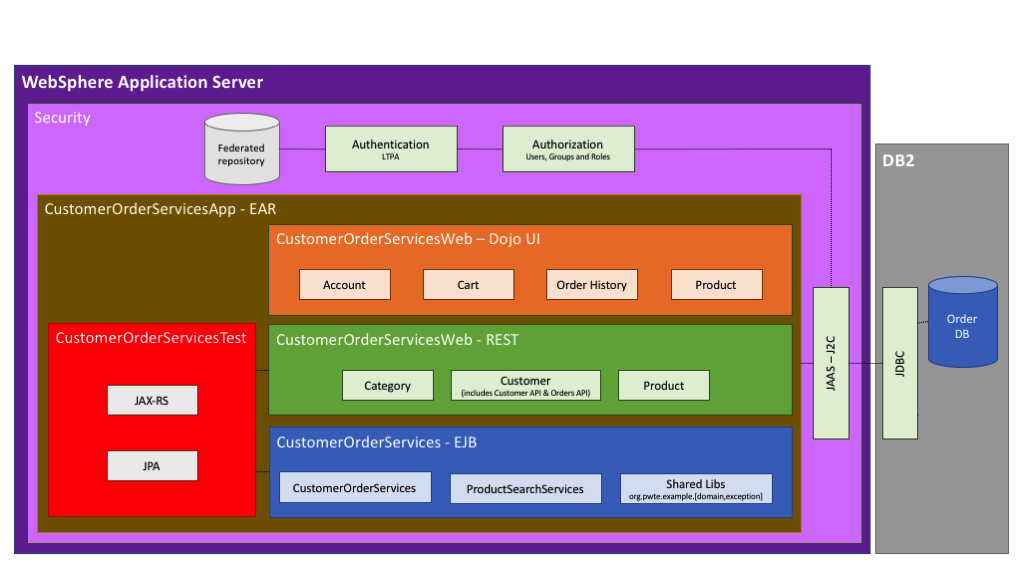Application modernization is a journey. It’s difficult enough to improve and refactor your own code. Modernizing 10+ years old code written by other developers is even harder. That’s why I recommend that application modernization needs to be a journey with many little baby steps.
Over the last weeks I’ve worked on a sample that shows how to modernize a Java EE application from 2010. Over the next days I’ll publish blogs that describe how I’ve done this in multiple stages.
You can get the complete source code of the sample from GitHub.
Sample Application – Starting Point
The sample application is a simple e-commerce shopping application built around 2010 with Java EE 6 running on WebSphere 8.5.5. You can navigate through products in a catalog via categories.
In order to purchase products, they can be added to the shopping cart via drag and drop.
The application has been built using the traditional 3 tier architecture model, with a web application frontend, EJB backend business logic and a SQL database. The source code is available in the ‘monolith-websphere-855‘ directory.
This is the architecture diagram from 2010.
Why should you modernize?
I’ve written another blog about why you should consider modernizing applications. One of the reasons is to improve operational efficiency.
When all enterprise applications run on container platforms like Kubernetes or OpenShift, they can be managed consistently. Everything is a container, no matter what programming languages and application stacks are used. This makes operations easier since observability like logging and monitoring are handled in the same way.
Containerizing legacy Applications
The first step in the modernization journey is to containerize applications. In order to run WebSphere applications in a container, IBM Cloud Transformation Advisor can be used.
There is a local version to run Transformation Advisor on your developer machine using Docker. Instructions how to run Transformation Advisor on the original version of the sample can be found in the repo.
Since setting up the sample in virtual machines or on bare metal is not that easy, the WebSphere 8.5.5 application is simulated running in a container.
Here is the result of running Transformation Advisor. ‘CustomerOrderServicesApp.ear’ is the application that is supposed to be containerzied and the estimated effort is low.
That’s because not a single line of code needs to be changed!
Instead Transformation Advisor generates a Dockerfile and two Python scripts automatically to run the same application in a container.
Here is the generated Dockerfile.
The only change that needed to be done was to replace ‘{APPLICATION_BINARY}’ with the actual ear file’s name.
1
2
3
4
5
6
7
FROM ibmcom/websphere-traditional:latest-ubi
# Manual fix: Replace {APPLICATION_BINARY} with CustomerOrderServicesApp-0.1.0-SNAPSHOT.ear
COPY --chown=was:root CustomerOrderServicesApp-0.1.0-SNAPSHOT.ear /work/config/CustomerOrderServicesApp-0.1.0-SNAPSHOT.ear
COPY --chown=was:root ./src/config /work/config
COPY --chown=was:root ./lib /work/config/lib
RUN /work/configure.sh
Running the Sample Application
In order to run the application locally, you can use Docker desktop.
Run these commands to run the original WebSphere 8.5.5 application:
1
2
3
4
5
$ git clone https://github.com/nheidloff/application-modernization-javaee-quarkus.git && cd application-modernization-javaee-quarkus
$ ROOT_FOLDER=$(pwd)
$ sh ${ROOT_FOLDER}/scripts/install-dojo.sh
$ sh ${ROOT_FOLDER}/scripts/install-was-dependencies.sh
$ sh ${ROOT_FOLDER}/scripts-docker/build-and-run-monolith-app-was855.sh
Run these commands to run the containerized version running on WebSphere Traditional 9.0:
1
2
3
4
5
$ git clone https://github.com/nheidloff/application-modernization-javaee-quarkus.git && cd application-modernization-javaee-quarkus
$ ROOT_FOLDER=$(pwd)
$ sh ${ROOT_FOLDER}/scripts/install-dojo.sh
$ sh ${ROOT_FOLDER}/scripts/install-was-dependencies.sh
$ sh ${ROOT_FOLDER}/scripts-docker/build-and-run-monolith-app-was90.sh
What’s next?
In one of the next blogs I’ll explain how to convert the WebSphere Traditional 9.0 application to WebSphere Liberty.





